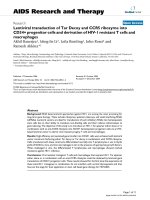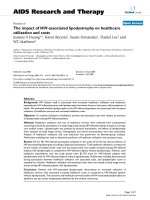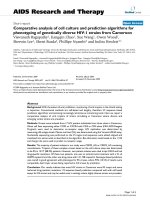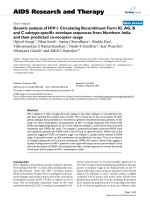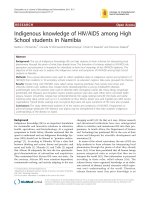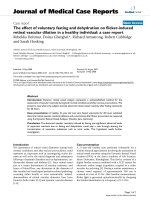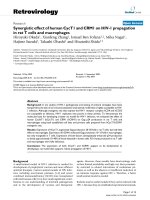Báo cáo y học: "Cost estimates of HIV care and treatment with and without anti-retroviral therapy at Arba Minch Hospital in southern Ethiopia" docx
Bạn đang xem bản rút gọn của tài liệu. Xem và tải ngay bản đầy đủ của tài liệu tại đây (232.03 KB, 7 trang )
BioMed Central
Page 1 of 7
(page number not for citation purposes)
Cost Effectiveness and Resource
Allocation
Open Access
Research
Cost estimates of HIV care and treatment with and without
anti-retroviral therapy at Arba Minch Hospital in southern Ethiopia
Asfaw Demissie Bikilla*
†1,2
, Degu Jerene
†3
, Bjarne Robberstad
†1,4
and
Bernt Lindtjorn
†1
Address:
1
Center for International Health, University of Bergen, PO Box 7804, 5020 Bergen, Norway,
2
Faculty of Business and Economics, Hawassa
University. PO Box 278, Hawassa, Ethiopia,
3
Arbaminch Hospital, Arba Minch, Ethiopia and
4
Department of Public Health and Primary Health
Care, University of Bergen, Bergen, Norway
Email: Asfaw Demissie Bikilla* - ; Degu Jerene - ; Bjarne Robberstad - ;
Bernt Lindtjorn -
* Corresponding author †Equal contributors
Abstract
Background: Little is known about the costs of HIV care in Ethiopia.
Objective: To estimate the average per person year (PPY) cost of care for HIV patients with and
without anti-retroviral therapy (ART) in a district hospital.
Methods: Data on costs and utilization of HIV-related services were taken from Arba Minch
Hospital (AMH) in southern Ethiopia. Mean annual outpatient and inpatient costs and
corresponding 95% confidence intervals (CI) were calculated. We adopted a district hospital
perspective and focused on hospital costs.
Findings: PPY average (95% CI) costs under ART were US$235.44 (US$218.11–252.78) and
US$29.44 (US$24.30–34.58) for outpatient and inpatient care, respectively. Estimates for the non-
ART condition were US$38.12 (US$34.36–41.88) and US$80.88 (US$63.66–98.11) for outpatient
and inpatient care, respectively. The major cost driver under the ART scheme was cost of ART
drugs, whereas it was inpatient care and treatment in the non-ART scheme.
Conclusion: The cost profile of ART at a district hospital level may be useful in the planning and
budgeting of implementing ART programs in Ethiopia. Further studies that focus on patient costs
are warranted to capture all patterns of service use and relevant costs. Economic evaluations
combining cost estimates with clinical outcomes would be useful for ranking of ART services.
Background
The prevalence of HIV in adults in Ethiopia is 2.1%
according to 2007 estimates [1]. About 242,548 adults liv-
ing with HIV/AIDS require anti-retroviral therapy (ART)
[1]. Ethiopia launched a nationwide ART program in Jan-
uary 2005 [2] with a policy to implement treatment to
rural settings through peripheral healthcare facilities. The
number of treatment sites had reached 272 by June 2007
[1]. Treatment coverage is about 35% [1], and the unmet
need for ART in Ethiopia remains considerable.
ART provision in Ethiopia is funded mainly through exter-
nal programs such as the Global Fund to Fight AIDS,
Tuberculosis and Malaria; the United States President's
Published: 13 April 2009
Cost Effectiveness and Resource Allocation 2009, 7:6 doi:10.1186/1478-7547-7-6
Received: 17 September 2008
Accepted: 13 April 2009
This article is available from: />© 2009 Bikilla et al; licensee BioMed Central Ltd.
This is an Open Access article distributed under the terms of the Creative Commons Attribution License ( />),
which permits unrestricted use, distribution, and reproduction in any medium, provided the original work is properly cited.
Cost Effectiveness and Resource Allocation 2009, 7:6 />Page 2 of 7
(page number not for citation purposes)
Emergency Plan For AIDS Relief; and other donor agen-
cies. External funding may not continue at its current level
as HIV becomes less of an emergency and more of a
chronic problem [3]. Ethiopia may therefore have to
assume the major share of the cost of care and treatment
in the future. This may involve policies and strategies that
ensure the cost-effectiveness and sustainability of the
intervention. A costing study of ART provision in Ethiopia
may offer useful insights into the functioning of such
treatment, and provide a premise for policy analysis and
debates. Specifically, cost analysis may create a ground for
economic evaluations through identification of inputs
and their valuations. It also provides an overview of the
cost profile of different components of an intervention,
and the total amount of resources needed to sustain or
expand a project [4].
Several region- and country-specific cost estimates of HIV-
related services have been reported, though cost estimates
from Africa are meagre. Bertozzi et al [5] reported a per
person year (PPY) cost of US$538 for ART-based care in
low-income countries based on data from sub-Saharan
African countries. A study from South Africa [6] stated that
the cost of ART decreased compared with a non-ART con-
dition; it also reported an average PPY cost ranging from
US$950 to US$3,520 for a non-ART condition, and
US$793 to US$964 under ART. Another study from South
Africa indicated an average PPY cost of US$580–956 for
the non-ART condition, and US$700–2192 under the ART
scheme [7]. A recent report from Haiti suggested that ART
costs approximately US$1000 PPY, of which 36% goes to
anti-retroviral (ARV) drugs [8].
In Ethiopia, cost analysis of HIV-related care and treat-
ment will have direct relevance to the implementation of
ART in rural settings because of the dearth of information
on ART cost. Our study aimed to estimate the average PPY
cost of care of HIV patients with and without ART in a dis-
trict hospital.
Method
Study setting
Our study was done at Arba Minch Hospital (AMH) in the
Southern Nation Nationalities and Peoples Region
(SNNPR) in Ethiopia. We received from the SNNPR
Health Bureau ethical clearance and permission to access
documents and patient records.
AMH has 158 beds and serves 1.5 million people. The
hospital started HIV-related interventions in the early
1990s [9]. The HIV Unit in AMH was upgraded in January
2002; and it started to offer ART in August 2003. The Ethi-
opian government launched a nationwide program with
free provision of ART in October 2005, and AMH became
part of this scheme.
Patient selection and the ART regimen at AMH followed
national recommendations and those set by the World
Health Organaization (WHO) [10-12]. AMH provided
treatment on an outpatient basis (though AIDS patients
with severe clinical manifestations could be admitted).
First-line drugs for adults included (Stavudine
40 mg or 30 mg
-
Lamivudine
150 mg
-Neverapine
200
mg,), (Zudovudine
300
mg
-Lamivudine
150 mg
-Neverapine
200 mg
), (Stavudine
40 mg or
30 mg
-Lamivudine
150 mg
-Efavirenz
600 mg
) and
(Zudovudine
300 mg
-Lamivudine
150 mg
-Efavirenz
600 mg
)
[11]. Patients were staged according to clinical manifesta-
tion, presence of AIDS-defining illnesses, and basic labo-
ratory tests. Complete blood cell (CBC) count and clinical
chemistry have been standard laboratory tests for HIV
patients at AMH since January 2003. CD4 count was
introduced in September 2005, but there was no viral load
analyzer. The HIV Clinic had one physician, one nurse,
one data clerk and two community healthworkers. The
data clerk maintained the Clinic database; the community
healthworkers monitored patients and made regular
home visits. AMH maintained a database of HIV patients
who received care and treatment.
Data collection
Cost data
Costing was done from the perspective of AMH, and
included outpatient and inpatient costs using an ingredi-
ent approach. Costs were estimated for direct capital and
recurrent inputs for final HIV-related services; shares from
overhead cost centres of the hospital (see below) were also
included.
Final services in relation to HIV care at AMH included out-
patient consultations at the HIV Clinic, laboratory tests,
imaging, drug provision, and inpatient services. Costs
incurred in providing these services were direct costs.
Costs of other work units of the hospital that facilitated
provision of final services comprised the overhead costs of
final services. Major overhead cost centres were adminis-
tration, maintenance, storage, medical records, pharmacy,
transport, domestic services (i.e., cleaning, security), laun-
dry, clothing, food and utilities. The Ethiopian fiscal year
starting 8 July 2004 and ending 7 July 2005 was used as
the base year, and cost data were collected retrospectively.
We identified the resource items used in HIV care, includ-
ing direct and overhead capital and recurrent inputs for
the base year. We obtained the 2004/5 price of drugs and
medical supplies from the Pharmaceuticals and Medical
Supplies Import and Wholesale Share Company (PHAR-
MID) and the SNNPR Health Bureau. We used 2005/6
prices if 2004/5 prices were not available. We retrieved
personnel cost and unit costs of each of the non-medical
supplies recurrent inputs from the financial records of the
accounts section of AMH. For capital inputs, we took the
Cost Effectiveness and Resource Allocation 2009, 7:6 />Page 3 of 7
(page number not for citation purposes)
2005/6 replacement price from the market. We assumed
that input costs obtained from the accounts section of
AMH, PHARMID, SNNPR Health Bureau, and replace-
ment values of capital items reflected market values of the
inputs. All costs were converted to the US dollar using the
average exchange rate in 2005 (US$ 1 = ETB 8.6649) [13],
and we adjusted the 2005/6 prices to the base year 2004/
5 values using the gross domestic product (GDP) deflator
for the year 2005/6 [14]. We calculated net present values
(NPV) and annuitized the cost of capital items using an
interest rate of 3% based on annual yields on government
bond [15].
Data on service use
We used two prospective cohorts of HIV-positive patients
who received care and treatment at AMH from January
2003 to March 2006 to estimate use of HIV-related health-
care services [9,16,17]. The first cohort comprised HIV
patients who received care without ART at the HIV Clinic
from 1 January 2003 to 8 April 2004 (15.2 months) and a
total of 80.81 person year observations (PYO). There were
203 HIV positive patients in this cohort and 181 (89%)
were in the non-AIDS state whereas 22 (11%) were in the
AIDS state. The second cohort comprised HIV patients
who received ART from August 2003 to March 2006 (31.2
months) with 222 PYO. The cohort had 209 HIV positive
patients out of which 154 (74%) were in the non-AIDS
state whereas 55 (26%) were in the AIDS state. Patients
aged <15 years upon enrolment were excluded from the
study.
For outpatients, we extracted the following information
from the outpatient database of the cohorts: demographic
characteristics; date of starting treatment; clinical stage
upon starting treatment; investigations done; drugs used;
frequency of outpatient visits to the HIV Clinic; and time
of discontinuing care at the HIV Clinic. Patients who did
not attend within 90 days after their next scheduled visit
were considered to be "lost to follow-up"
We retrieved inpatient service records for all 58 HIV
patients who had been admitted to AMH during 2004/5
because the HIV Clinic database did not contain informa-
tion regarding inpatient clinical events and service use.
Twenty-five patients were on ART and 33 patients were
not. We collected the following data from the patient
chart: demographic characteristics; number of inpatient
days; clinical stage upon admission; investigations done;
and ARV and non-ARV drugs used.
Data Analysis
Unit costs of HIV-related services at AMH
We calculated average unit costs of each of the services by
dividing the cost of inputs incurred along each of the serv-
ices during the base year by the total number of output of
the respective services during the base year.
We allocated hospital overhead costs to final HIV-related
services using a "stepping-down" approach [18]. We used
floor area to allocate utilities, maintenance and domestic
service costs. The numbers of staff in each department
were used to allocate administration and clothing costs;
number of patients or quantity of service were used to
allocate central store, medical records and pharmacy/dis-
pensary costs to different activities. We allocated transport
costs as a function of the direct cost of each of the final
service units.
Service use and mean annual cost of care
We approximated the use of outpatient-based HIV-related
services by the frequency of visits to the HIV Clinic, labo-
ratory and imaging tests each patient underwent during
follow-up, and by the quantity and frequency of prescrip-
tion of ARV and other drugs. We extracted these data from
the outpatient database of the HIV Clinic. Mean annual
service use, confidence intervals at 95%, and correspond-
ing costs were calculated as ratios of the frequencies of use
of each service to the total PYO.
In estimating inpatient costs, we evaluated annual use of
inpatient services for the 58 HIV patients (33 non-ART
and 25 ART) who were admitted during the fiscal year
2004/5. Variables associated with inpatient service
included the number of non-ARV drugs taken, investiga-
tions (laboratory, imaging) done, general inpatient care,
and meals. The cost of drugs and investigations were esti-
mated based on the amount consumed by each patient,
but we used the number of inpatient days to estimate the
cost of general inpatient care and for treatment other than
drugs and diagnostics. We then multiplied the quantity of
service each patient used with the respective unit cost to
obtain the annual cost of inpatient service for each
patient. Mean PPY cost and the corresponding 95% confi-
dence interval were estimated from aggregated data.
We used the CostIt [19] spreadsheet to categorize and
summarize data of hospital costs, and SPSS 14.1 software
for statistical analysis of patient data.
Results
Unit costs
Table 1 shows the direct, overhead and aggregate unit
costs of HIV-related hospital services for the base year
2004/5. CD4 test was the most expensive HIV-related
service (cost, US$6.8 per unit) whereas other laboratory
tests (e.g., stool, sputum, blood film) were the cheapest
(cost, US$0.9 per unit). The overhead share of unit costs
ranged from 6% for CD4 count to 56% for outpatient con-
sultation. The capital component appeared to contribute
Cost Effectiveness and Resource Allocation 2009, 7:6 />Page 4 of 7
(page number not for citation purposes)
Table 1: Unit cost of HIV-related services at AMH for the base year 2004/5 in US $ ($ 1 = 8.6649 ETB)
Direct unit costs Overhead unit costs Combined
Cost items Recurrent Capital. Total Recurrent Capital. Total Recurrent Capital Total
Consultation at HIV Clinic 1.13 0.19 1.32 1.18 0.48 1.66 2.31 0.67 2.98
Laboratory 0.24
1
0.17
1
0.41
1
Haematology (CBC) 0.50 0.98 1.48 0.24 0.17 0.41 0.74 1.14 1.88
Clinical chemistry 0.77 0.48 1.25 0.24 0.17 0.41 1.01 0.64 1.65
CD4 0.79 5.72 6.51 0.24 0.17 0.41 1.03 5.89 6.92
Other tests 0.39 0.07 0.46 0.24 0.17 0.41 0.62 0.24 0.87
Imaging 0.64 1.72 2.37 1.33 0.81 2.13 1.97 2.53 4.50
Inpatient services
2
Treatment and care (medical ward) 1.11 0.29 1.40 1.01 0.33 1.34 2.12 0.61 2.74
Meal (all wards) 0.77 0.13 0.90 0.77 0.13 0.90
1
Overhead costs were calculated by dividing the total laboratory overhead cost by the total number of laboratory tests during the base year. The
recurrent and capital unit overhead costs therefore remained constant for all types of test.
2
Unit costs of inpatient services are expressed as costs per inpatient days.
Table 2: Average annual per patient use (95% CI) of hospital services by ART and AIDS status at AMH (2004/5)
Non-ART ART
Services categories Total non-AIDS AIDS Total non-AIDS AIDS
Outpatient services PYO* = 80.82 PYO = 75.24 PYO = 5.58 PYO = 221.98 PYO = 181.13 PYO = 40.85
Consultation at HIV Clinic 4.6(4.3–5.0) 4.5(4.1–4.9) 5.9(4.0–7.9) 11.4(11.0–11.7) 11.4(11.0–11.8) 11.3(10.5–12.1)
Laboratory
Haematology (CBC) 4.4(4.0–4.8) 4.3(3.9–4.9) 5.4(3.5–7.3) 3.1(2.96–3.2) 3(2.9–3.2) 3.3(2.9–3.7)
Clinical chemistry 1.1(0.9–1.3) 1.1(0.8–1.3) 1.3(0.1–2.4) 3.1(2.9–3.2) 3.1(2.9–3.2) 3.2(2.8–3.6)
CD4 0.0 0 0 0.4(0.3–0.4) 0.4(0.3–0.4) 0.3(0.2–0.5)
Other tests 0.3(0.2–0.5) 0.3(0.2–0.4) 0.7(0.1–1.6) 0.3(0.2–0.4) 0.3(0.2–0.4) 0.4(0.2–0.5)
Imaging 0.7(0.5–0.9) 0.6(0.5–0.8) 1.6(0.6–2.6) 0.1(0.05–0.13) 0.1(0.0–0.1) 0.1(0.0–0.2)
Anti Retroviral drugs
Zudovudine (300 mg) 0.0 0 0 28.7(13.3–44.1) 33.4(14.6–52.1) 8.3(0.0–16.7)
3TC (150 mg) 0.0 0 0 548.2(515.2–581.1) 551.1(515.2–587.0) 535.0(451–618.9)
Stavudine (d4T; 40 mg) 0.0 0 0 205.1(162.4–247.8) 224.3(175.3–273.2) 120.4(44.9–195.8)
Stavudine (d4T; 30 mg) 0.0 0 0 317.7(268.2–367.1) 297.7(242.6–352.8) 406.2(294.7–517.8)
Neverapine (200 mg) 0.0 0 0 401.2(353–449.4) 402.8(349.4–456.1) 394.3(277.9–510.7)
Effavirenze (600 mg) 0.0 0 0 113.3(89.6–137.0) 112.1(85.7–138.4) 118.9(63–174.8)
Zudovidine+3TC 450 mg 0.0 0 0 88.3(59.9–116.7) 88.6(57.2–120.1) 86.8(18.8–154.8)
Non-ARV drugs
1
10.9(8.4–13.3) 10.0(7.6–12.4) 22.4(7.8–37.0) 3.8(3.1–4.5) 3.9(3.0–4.7) 3.5(2.6–4.5)
Inpatient services n = 33 n = 13 n = 20 n = 25 n = 19 n = 6
Laboratory
Haematology (CBC) 0.9(0.7–1.0) 0.9(0.5–1.2) 0.9(0.6–1.1) 0.7(0.5–0.9) 0.7(0.5–1.0) 0.7(0.1–1.2)
Clinical chemistry 0.4(0.2–0.6) 0.3(0.1–0.7) 0.5(0.2–0.7) 0.4(0.2–0.7) 0.5(0.2–0.7) 0.3(-0.2–0.9)
CD4 0.00 0 0 0.08(0.03–0.19) 0.1(0.05–0.3) 0
Other tests 1.3(0.8–1.7) 1.31(0.5–2.1) 1.3(0.7–1.6) 0.5(0.1–0.9) 0.5(0.1–0.9) 0.7(0.6–1.9)
Imaging 0.5(0.3–0.7) 0.4(0.01–0.8) 0.6(0.3–0.9) 0.08(0.03–0.19) 0.1(0.06–0.16) 0.17(0.06–0.60)
Non-ARVdrug
1
11.3(8.8–13.9) 11.2(7.7–14.7) 11.4(7.6–15.2) 5.5(3.9–7.1) 5.7(3.7–7.6) 5.0(0.9–9.0)
Mean number of inpatient
days
17.6(13.1–22.1) 12.2(6.2–18.1) 21.1(14.9–27.3) 5.6(4.4–6.9 4.5(3.5–5.6) 9.2(5.7–12.6)
*Person year observation
1
Utilization is expressed in terms of US $.
Cost Effectiveness and Resource Allocation 2009, 7:6 />Page 5 of 7
(page number not for citation purposes)
the major share of the unit cost for CD4 count, haematol-
ogy test, and imaging examination with 85%, 61% and
56% of the totals, respectively. Recurrent costs were the
major components of the outpatient consultation, clinical
chemistry and other laboratory tests, and accounted for
78%, 71% and 61% of the totals, respectively.
Use of hospital service
Table 2 summarizes the mean annual service utilization of
HIV patients at AMH. HIV patients who were on ART
tended to have more outpatient consultations and clinical
chemistry tests than those who were not on ART. Mean
annual use of imaging, and outpatient-based haematol-
ogy tests appeared to be higher in the non-ART group than
in the ART group. Use of inpatient-based laboratory tests
appeared to be similar in the two groups. Patients on ART
had fewer inpatient days than those who were not on ART.
Except in the use of outpatient-based non-ARV drugs in
the absence of ART and the number of inpatient days
under non-ART and ART conditions, it appeared that there
was no major difference in service use between the non-
AIDS and AIDS states within each treatment condition.
AIDS patients not on ART used more non-ARV drugs than
those patients without AIDS, whereas this was compara-
ble for those who were on ART. Under both treatment
conditions, those in the latter stage of AIDS had more
inpatient days than those without AIDS.
Mean annual cost of care and treatment of HIV
Table 3 shows the average PPY cost of outpatient and
inpatient HIV care at AMH. Overall costs of inpatient care
appeared to be higher under the non-ART condition than
the ART condition, but the cost of outpatient-based serv-
ices was higher under the ART situation. The PPY costs of
care without ART were US$38 and US$81 for outpatient
and inpatient services, respectively. With ART, outpatient
costs increased to US$235, whereas inpatient costs
decreased to US$29. Cost of ARV drugs was the major cost
driver under ART (78% of outpatient costs). There are
large differences in costs between patients depending on
whether or not they have AIDS for all inpatients services
and for all outpatients not receiving ART. Except for the
costs of outpatient services to those receiving ART, both
the outpatient and inpatient costs are higher for patients
with AIDS within both the non-ART and ART conditions.
Discussion
Principal finding
We found that the cost of care under ART appeared to be
higher than that under the non-ART condition in a district
hospital setting in Ethiopia. Mean annual outpatient and
inpatient costs of treating HIV patients with ART were
US$265, and US$119 without ART. The cost of ARV drugs
was the major cost element, and accounted for >70% of
the annual cost under ART. Inpatient care and treatment
Table 3: Average per patient year cost (95% CI) of HIV related services in US$* at Arba Minch Hospital by ART and AIDS status (2004/
5)
Non-ART ART
Cost categories Total Non-AIDS AIDS Total Non-AIDS AIDS
Outpatient services
HIV Clinic consultation 13.8(12.7–14.9) 13.5(12.4–14.6) 17.6(11.8–23.4) 33.9(32.9–35.0) 33.9(32.8–35.1) 33.7(31.4–36.0)
Laboratory 10.3(9.3–11.3) 10.1(9.1–11.2) 12.8(7.5–18.2) 13.7(12.9–14.4) 13.5(12.7–14.3) 14.4(12.5–16.2)
Imaging 3.2(2.4–3.9) 2.9(2.2–3.6) 7.3(2.8–11.7) 0.4(0.2–0.6) 0.4(0.2–0.6) 0.3(0.04–0.7)
ARV drugs 0.00 0 0 183.7(167.0–200.4) 183.9(165.6–202.3) 182.7(140.9–224.5)
Non-ARV drugs 10.9(8.4–13.3) 10.0(7.6–12.4) 22.4(7.8–37.0) 3.8(3.1–4.5) 3.9(3.0–4.7) 3.5(2.6–4.5)
Total per patient
annual cost of
outpatient care
38.1(34.4–41.9) 36.5(32.8–40.2) 60.1(35.5–84.6) 235.4(218.1–252.8) 235.6(216.5–254.8) 234.6(192.5–276.7)
Inpatient services
Laboratory 3.4(2.7–4.0) 3.2(2.1–4.4) 3.4(2.5–4.3) 3.1(2.1–4.1) 3.3(2.1–4.5) 2.4(0.4–4.4)
Imaging 2.3(1.3–3.3) 1.7(0.04–3.5) 2.7(1.4–4.0) 0.4(0.2–0.9) 0.24(0.2–0.7 0.8(0.18–2.68)
Non-ARV drugs 11.3(8.8–13.9) 11.2(7.7–14.7) 11.4(7.6–15.2) 5.5(3.9–7.1) 5.7(3.7–7.6) 5.0(0.9–9.0)
Treatment and care 48.1(35.9–60.3) 33.2(17.1–49.4) 57.7(40.8–74.6) 15.4(11.9–19.0) 12.4(9.6–15.2) 25.1(15.6–34.6)
Meals 15.8(11.8–19.9) 10.9(5,6–16.3) 19.0(13.4–24.6) 5.1(3.9–6.2) 4.1(3.2–5.0) 8.3(5.1–11.4)
Total per patient
annual cost of inpatient
care
80.9(63.7–98.1) 60.4(35.2–85.5) 94.2(71.3–117.2) 29.4(24.3–34.6) 25.7(20.9–30.4) 41.4(27.8–55.1)
Cost Effectiveness and Resource Allocation 2009, 7:6 />Page 6 of 7
(page number not for citation purposes)
was the most important cost if patients did not receive
ART.
Discussion of main findings
Unit costs derived in our study (i.e., US$2.98 per outpa-
tient visits and US$3.64 per inpatient day) were higher
than those reported by WHO for secondary-level hospitals
in Ethiopia for year 2000. WHO values were US$0.43 per
outpatient visit and US$1.77 per inpatient day [20]. Our
estimates were service-specific, whereas WHO estimates
were aggregates for all services, which may explain the dif-
ference. Nevertheless, unit costs in our study were less
than those reported from a recent study in South Africa.
Cleary et al. [7] reported unit costs of US$18.92 and
US$19.33 for an outpatient clinic visit under non-ART
and ART conditions, respectively. This is probably because
South Africa is a medium-income country with a higher
level of general cost than Ethiopia.
Mean estimates of PPY outpatient visits in our study for
non-AIDS and AIDS patients (4.5 and 5.9, respectively,
and 4.6 combined) under the non-ART condition were
similar to those found in other studies. A study from Mex-
ico reported pre-ART mean annual outpatient visits of
4.6–6.3 [21]. A study from South-Africa [6] estimated an
average PPY outpatient visit of 4.35 and 6.6 for non-AIDS
and AIDS groups, respectively, under the non-ART condi-
tion. Our estimates of outpatient visits for non-AIDS and
AIDS categories under ART (11.37 and 11.31, respectively,
and 11.36 combined) were less than the 15 visits PPY
reported in a study from Haiti [8] (though slightly higher
than the Mexican and South African studies). The study
from Mexico reported post-ART PPY outpatient visits of
8.9–10.3 [21], whereas the South African study reported
PPY outpatient visits of 8.71 and 7.62 for the non-AIDS
and AIDS categories, respectively, under the ART scenario
[6].
Our estimates of PPY inpatient days appeared higher
under non-ART and ART conditions than the estimates
from the South African and Mexican studies. The South
African study reported PPY inpatient days of 3.75 and
15.36 for non-AIDS and AIDS stages, respectively, under
the non-ART condition; and 1.08 and 2.04 for non-AIDS
and AIDS states, respectively, under the ART scenario. Esti-
mates from the Mexican study were even lower: PPY inpa-
tient days were 0.7–2.2 in the pre-ART period, and 1.3–
1.9 in the post-ART period.
Total costs of HIV care and treatment in our study were
more favourable than earlier studies [6-8], with annual
per patient costs of outpatient and inpatient services being
significantly lower. Direct comparison of cost values from
different settings may not be straightforward due to differ-
ent assumptions and study designs, but cost values in our
study may have appeared favourable because Ethiopia is a
poor country with low levels of income, and relatively low
prices of domestic inputs.
Study limitations
We applied an ingredient approach for cost estimation, so
most of the inputs for final HIV-related services and over-
head activities were considered in the cost estimation.
Nevertheless, certain limitations and shortcomings in our
costing approach are evident.
First, we applied average (unit) cost in estimating service
costs, which is the commonest approach in costing studies
of health services. Such estimation of unit cost is likely to
be affected by the quantity of service delivered during a
specified period [18]. Service categories that operate out-
side their optimum capacity are therefore likely to have
higher unit costs. The HIV Clinic at AMH probably treated
fewer patients than its capacity because ART was intro-
duced in Ethiopia recently and coverage is low. Estimated
unit costs may therefore have been overstated. The alter-
native could be estimating each of the inputs required to
provide each service to a single patient.
Second, we applied identical unit costs of service for non-
ART and ART conditions. The intensity of use of services
under the two scenarios could differ, and consequently
the unit cost of delivering the services may vary, as indi-
cated by Cleary et al [7].
Third, our estimation of in-patient costs was based on a
small sample of patients and data on service use for a sin-
gle year. This resulted in fewer patients in the AIDS and
non-aids categories; and the limited duration of follow-up
may not capture the pattern of service use and the corre-
sponding cost over several years. This might affect the pre-
cision of the estimates and the result may need to be
interpreted carefully. Although small samples may affect
precision of estimates, we calculated confidence intervals,
and believe our results represent important information
for utilization of the data in economic evaluation models.
Our limited sample size was because of the difficulty of
retrieving retrospective in-patient service-use data for HIV
patients at AMH. We had to retrieve data on in-patient
service use of HIV patients from the general patient
records (which we could get for only a single year)
because the HIV database at AMH focused on outpatient
care and treatment follow-up. Thus, it may be important
for healthcare facilities to keep a comprehensive database
that covers all clinical events of patients under their care.
Conclusion
In spite of its limitations, our study highlighted the aver-
age cost profile of ART in a district hospital in Ethiopia,
Publish with Bio Med Central and every
scientist can read your work free of charge
"BioMed Central will be the most significant development for
disseminating the results of biomedical research in our lifetime."
Sir Paul Nurse, Cancer Research UK
Your research papers will be:
available free of charge to the entire biomedical community
peer reviewed and published immediately upon acceptance
cited in PubMed and archived on PubMed Central
yours — you keep the copyright
Submit your manuscript here:
/>BioMedcentral
Cost Effectiveness and Resource Allocation 2009, 7:6 />Page 7 of 7
(page number not for citation purposes)
and the results may have direct application for program
planning. At a district hospital, on average, about US$235
and US$30 PPY must be spent for outpatient and inpa-
tient care, respectively, for patients on ART. This is more
than twice as high as the costs of non-ART services. This
finding indicates that an economic evaluation of ART, in
Ethiopia, would be valuable to consider if incremental
costs per incremental life years is reasonable value-for-
money.
Our cost estimates are important information for the
implementation of ART in Ethiopia, but further studies
that focus on patient costs may be warranted to capture all
patterns of service use.
Competing interests
The authors declare that they have no competing interests.
Authors' contributions
ADB designed the study, analyzed the data, and wrote the
manuscript. DJ established the AMH cohort database and
helped to edit the manuscript. BR contributed to study
design, data analysis, writing and approving the manu-
script. BL contributed to the conception and design of the
study; data analysis, writing and approving the manu-
script
Acknowledgements
The study was financially supported by the Centre for International Health,
University of Bergen; and the Norwegian State Loan Fund for Education.
References
1. Report on Progress towards Implementation of the UN Dec-
laration of Commitment on HIV/AIDS: Federal Democratic
Republic of Ethiopia. Addis Ababa: Federal HIV/AIDS Prevention
and Control Office; 2008.
2. MOH: AIDS in Ethiopia 6th Report. 2006.
3. IOM: PEPFAR Implementation: Progress and Promise. 2007.
4. UNAIDS ADB: Costing Guidelines for HIV/AIDS Intervention Strategies:
For use in estimating resource needs, scaling-up and strategic planning in
the Asia/Pacific region Geneva, Manila: UNAIDS; 2004.
5. Bertozzi S, Gutierrez J, Opuni M, Walker N, Schwartander B: Esti-
mating resource needs for HIV/AIDS health care services in
low-income and middle-income countries. Health Policy 2004,
69:189-200.
6. Badri M, Maartens G, Mandalia S, Bekker LG, Penrod JR, Platt RW,
Wood R, Beck EJ: Cost-Effectiveness of Highly Active Antiret-
roviral Therapy in South Africa. PLoS Med 2006, 3(1):e4.
7. Cleary SM, McIntyre D, Boulle AM: The cost-effectiveness of
Antiretroviral Treatment in Khayelitsha, South Africa – a
primary data analysis. Cost Eff Resour Alloc 2006, 4(20):.
8. Koenig SP, Rivers C, Leger P, Severe P, Atwood S, Fitzgerald D, Pape
JW, Schackman BR: The cost of antiretroviral therapy in Haiti.
Cost Effectiveness and Resource Allocation 2008, 6(3):.
9. Jerene D, Lindtjorn B: Disease Progression Among Untreated
HIV-Infected Patients in South Ethiopia: Implication for
Patient Care. MedGenMed 2005, 7(3):.
10. MOH: Guidelines for use of Antiretroviral drugs in Ethiopia.
2003.
11. MOH: Chronic HIV Care with ARV Therapy: Guideline for
First level facility health workers. 2005.
12. WHO: Scaling-up antiretroviral therapy in resource limited
settings: Treatment guideline for a public health approach.
2003 revision. 2004.
13. National Bank of Ethiopia: Exchange Rates Development. Addis
Ababa: NBE; 2006.
14. IMF: IMF Executive Board Concludes 2005 Article IV Consul-
tation with the Federal Democratic Republic of Ethiopia.
2006.
15. National Bank of Ethiopia: Treasury Department; 2006.
16. Jerene D, Naess A, Lindtjorn B: Antiretroviral therapy at a dis-
trict hospital in Ethiopia prevents death and tuberculosis in
a cohort of HIV patients. AIDS Research and Therapy 2006, 3(10):.
17. Jerene D:
HIV antiretroviral therapy in Ethiopia: Overcoming
implementation challenges. In Dissertation for the degree of philos-
ophiae doctor (PhD) University of Bergen, Centre for International
Health; 2007.
18. Drummond M, Sculpher MJ, Torrancege GW, O'Brien BJ, Stoddart ,
Greg L: Methods for the Economic Evaluation of Health Care Programs
Third edition. Oxford: Oxford University Press; 2005.
19. Adam T, Aikins M, Evans D: CostIt Software 2005. World Health
Organization; 2005.
20. Estimates of Unit costs for Patient services for Ethiopia
[ />]
21. Bautista S, Dmytraczenko T, Kombe G, Bertozi S: Costing of HIV/
AIDS Treatment in Mexico. PHRplus 2003.

